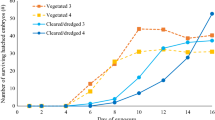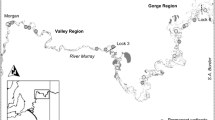Abstract
Wetland hydroperiod is a key factor for the reproductive success of pond-breeding amphibians. Ground-water withdrawals may cause intermittent ponds to dry prematurely, potentially affecting amphibian development. In three intermittent ponds, we monitored hydrology and tracked oviposition, larval development, and metamorphosis for three frog species that represented a range of breeding phenologies. The three species were the southern leopard frog (Lithobates sphenocephalus), spring peeper (Pseudacris crucifer), and Pine Barrens treefrog (Hyla andersonii). We simulated ground-water withdrawals by subtracting from 5 to 50 cm (in 5-cm increments) from the measured water-depth values at the ponds over a short-term (2-year) period and a long-term (10-year) period to estimate the potential impact of hydroperiod alterations on frog development. Short-term simulations indicated that 5 and 10 cm water-depth reductions would have resulted in little or no impact to hydroperiod or larval development and metamorphosis of any of the species. Noticeable impacts were estimated to occur for reductions ≥15 cm. Long-term simulations showed that impacts to the appearance of the first pre-metamorphs and metamorphs would have occurred at reductions ≥10 cm and impacts to initial egg deposition would have occurred at reductions ≥20 cm. For all simulations, successively greater reductions would have caused increasing impacts that varied by species and pond, with the 50-cm reductions shortening hydroperiods enough to practically eliminate the possibility of larval development and metamorphosis for all three species. Compared to the spring peeper and southern leopard frog, the estimated impacts of the simulations on the various life stages were the greatest for the Pine Barrens treefrog.






Similar content being viewed by others
References
Altig R (1970) A key to the tadpoles of the continental United States and Canada. Herpetologica 26:180–207
Berven KA (1990) Factors affecting population fluctuations in larval and adult stages of the wood frog (Rana sylvatica). Ecology 71:1599–1608
Boone MD (2005) Juvenile frogs compensate for small metamorph size with terrestrial growth: overcoming the effects of larval density and insecticide exposure. J Herpetol 39:416–423
Bunnell JF, Zampella RA (1999) Acid water anuran pond communities along a regional forest to agro-urban ecotone. Copeia 1999:614–627
Bunnell JF, Zampella RA (2008) Native fish and anuran assemblages differ between impoundments with and without non-native centrarchids and bullfrogs. Copeia 2008:931–939
Caldwell JP (1986) Selection of egg deposition sites: a seasonal shift in the southern leopard frog, Rana sphenocephala. Copeia 1986:249–253
Crother BI (2008) Scientific and standard English names of amphibians and reptiles of North America North of Mexico, pp 1–84, SSAR Herpetological Circular 37
Crump ML (1989) Effect of habitat drying on developmental time and size at metamorphosis in Hyla pseudopuma. Copeia 1989:794–797
Denver RJ (1997) Proximate mechanisms of phenotypic plasticity in amphibian metamorphosis. Am Zool 37:172–184
Denver RJ, Mirhadi N, Phillips M (1998) Adaptive plasticity in amphibian metamorphosis: response of Scaphiopus hammondii tadpoles to habitat desiccation. Ecology 79:1859–1872
Faragher SG, Jaeger RG (1998) Tadpole bullies: examining mechanisms of competition in a community of larval anurans. Can J Zool 76:144–153
Gibbons JW, Winne CT, Scott DE, Willson JD, Glaudas X, Andrews KM, Todd BD, Fedewa LA, Wilkinson L, Tsaliagos RN, Harper SJ, Greene JL, Tuberville TD, Metts BS, Dorcas ME, Nestor JP, Young CA, Akre T, Reed RN, Buhlmann KA, Norman J, Croshaw DA, Hagen C, Rothermel BB (2006) Remarkable amphibian biomass and abundance in an isolated wetland: implications for wetland conservation. Conserv Biol 20:1457–1465
Gosner KL (1960) A simplified table for staging anuran embryos and larvae with notes on identification. Herpetologica 16:183–190
Gosner KL, Black IH (1957) The effects of acidity on the development and hatching of New Jersey frogs. Ecology 38:256–262
Hulme MG, Jenkins J, Lu X, Turnpenny JR, Mitchell TD, Jones RG, Lowe J, Murphy JM, Hassell D, Boorman P, McDonald R, Hill S (2002) Climate change scenarios for the United Kingdom: the UKCIP02 scientific report. Tyndall Center for Climate Change Research, Norwich
IPCC (2001) Climate change 2001: the scientific basis. In: Houghton JT, Ding Y, Griggs DJ, Noguer M, van der Linden PJ, Dai X, Maskell K, Johnson CA (eds) Contribution of working group I to the third assessment report of the intergovernmental panel on climate change. Cambridge University Press, Cambridge
Laidig KJ, Zampella RA, Sulikowski TM, Bunnell JF, Dow CL (2001) Characteristics of selected Pine Barrens treefrog ponds in the New Jersey Pinelands. New Jersey Pinelands Commission, New Lisbon. http://www.nj.gov/pinelands/
Leips J, McManus MG, Travis J (2000) Response of treefrog larvae to drying ponds: comparing temporary and permanent pond breeders. Ecology 81:2997–3008
Lide RF, Meetemeyer VG, Pinder JE III, Beatty LM (1995) Hydrology of a Carolina Bay located on the upper coastal plain of western South Carolina. Wetlands 15:47–57
Martof BS (1956) Growth and development of the green frog, Rana clamitans, under natural conditions. Am Midl Nat 55:101–117
Martof BS, Palmer WM, Bailey JR, Harrison JR (1980) Amphibians and reptiles of the Carolinas and Virginia. University of North Carolina Press, Chapel Hill
Mast MA, Turk JT (1999) Environmental characteristics and water quality of hydrologic benchmark network stations in the eastern United States, 1963–1995. U.S. Geological Survey Circular 1173-A, Trenton
McCallum ML, Trauth SE, Mary MN, McDowell C, Wheeler BA (2004) Fall breeding of the southern leopard frog (Rana sphenocephala) in northeastern Arkansas. Southeast Nat 3:401–408
McHorney R, Neill C (2007) Alteration of water levels in a Massachusetts coastal plain pond subject to municipal ground-water withdrawals. Wetlands 27:366–380
Morin PJ, Lawler SP, Johnson EA (1990) Ecology and breeding phenology of larval Hyla andersonii: the disadvantages of breeding late. Ecology 71:1590–1598
Otto CR, Forester DC, Snodgrass JW (2007) Influences of wetland and landscape characteristics on the distribution of carpenter frogs. Wetlands 27:261–269
Parris MJ (2000) Experimental analysis of hybridization in leopard frogs (Anura: Ranidae): larval performance in desiccating environments. Copeia 2000:11–19
Paton PWC, Crouch WB (2002) Using the phenology of pond-breeding amphibians to develop conservation strategies. Conserv Biol 16:192–204
Pechmann JHK, Scott DE, Gibbons JW, Semlitsch RD (1989) Influence of wetland hydroperiod on diversity and abundance of metamorphosing juvenile amphibians. Wetl Ecol Manag 1:3–11
Pinelands Commission (2003) The Kirkwood–Cohansey project work plan. Pinelands Commission, New Lisbon. http://www.nj.gov/pinelands/
Rhodehamel EC (1979a) Hydrology of the New Jersey Pine Barrens. In: Forman RTT (ed) Pine Barrens: ecosystem and landscape. Academic Press, New York, pp 147–167
Rhodehamel EC (1979b) Geology of the Pine Barrens of New Jersey. In: Forman RTT (ed) Pine Barrens: ecosystem and landscape. Academic Press, New York, pp 39–60
Rowe CL, Dunson WA (1995) Impacts of hydroperiod on growth and survival of larval amphibians in temporary ponds of central Pennsylvania, USA. Oecologia 102:397–403
Ryan J (2007) Hydroperiod and metamorphosis in small-mouthed salamanders (Ambystoma texanum). Northeast Nat 14:619–628
Ryan TJ, Winne CT (2001) Effects of hydroperiod on metamorphosis in Rana sphenocephala. Am Midl Nat 145:46–53
Semlitsch RD, Scott DE, Pechmann JHK, Gibbons JW (1996) Structure and dynamics of an amphibian community: evidence from a 16-year study of a natural pond. In: Long-term studies of vertebrate communities. Academic Press, San Diego, pp 217–248
Siegel S, Casetllan NJ Jr (1988) Nonparametric statistics for the behavioral sciences, 2nd edn. McGraw-Hill, Inc, New York
Standaert WF (1967) Growth, maturation, and population ecology of the carpenter frog (Rana virgatipes, Cope). Dissertation, Rutgers University
Werner EE, McPeek MA (1994) Direct and indirect effects of predators on two anuran species along an environmental gradient. Ecology 75:1368–1382
Werner EE, Wellborn GA, McPeek MA (1995) Diet composition in postmetamorphic bullfrogs and greenfrogs: implications for interspecific predation and competition. J Herpetol 29:600–607
Wright AH, Wright AA (1949) Handbook of frogs and toads of the United States and Canada, 3rd edn. Comstock Publishing Associates, Ithaca
Zampella RA, Bunnell JF (2000) The distribution of anurans in two river systems of a Coastal Plain watershed. J Herpetol 34:210–221
Zampella RA, Laidig KJ (2003) Functional equivalency of natural and excavated Coastal Plain ponds. Wetlands 23:860–876
Zampella RA, Dow CL, Bunnell JF (2001a) Using reference sites and simple linear regression to estimate long-term water levels in Coastal Plain forests. J Am Water Resour Assoc 37:1189–1201
Zampella RA, Bunnell JF, Laidig KJ, Dow CL (2001b) The Mullica River Basin: a report to the Pinelands Commission on the status of the landscape and selected aquatic and wetland resources. Pinelands Commission, New Lisbon. http://www.nj.gov/pinelands/
Zapecza OS (1989) Hydrogeologic framework of the New Jersey Coastal Plain: regional aquifer-system analysis—northern Atlantic Coastal Plain. U.S. Geological Professional Paper 1404-B. U.S. Geological Survey, Trenton
Acknowledgments
We thank Robert A. Zampella for advice throughout the study, Kimberly S. Spiegel for assistance with larval sampling, and two anonymous reviewers for comments that improved the manuscript. The New Jersey Department of Environmental Protection Endangered and Nongame Species Program provided the necessary amphibian permits. The study was conducted with funding provided through the Water Supply Fund in accordance with New Jersey Public Law 2001, Chapter 165 and the National Park Service.
Author information
Authors and Affiliations
Corresponding author
Rights and permissions
About this article
Cite this article
Bunnell, J.F., Ciraolo, J.L. The potential impact of simulated ground-water withdrawals on the oviposition, larval development, and metamorphosis of pond-breeding frogs. Wetlands Ecol Manage 18, 495–509 (2010). https://doi.org/10.1007/s11273-010-9182-2
Received:
Accepted:
Published:
Issue Date:
DOI: https://doi.org/10.1007/s11273-010-9182-2




